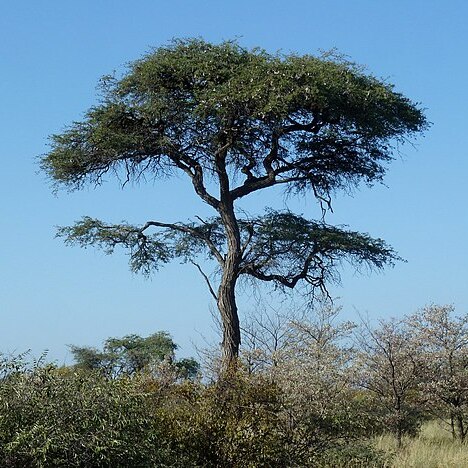Tree up to 15 m high or less frequently a shrub to 4 m high; trunk to 1 m in diam.; crown rounded, the branches often drooping somewhat, or flattened and spreading. Bark dark greyish-brown to blackish, rough, fissured, often flaking off in thick ± woody sections when old; young branchlets pale to dark grey-or reddish-brown to purple, sometimes as though whitewashed over a purplish background, often flaking minutely, glabrous or subglabrous, seldom pubescent. Stipules spinescent, in pairs, 0.5-5(10) cm long, usually rather stout, often thickened below and fused together basally into an enlarged 'ant-gall', 1.5-2 x 2-2.5 cm, sometimes furrowed down the middle, tapering to a sharp point apically; other prickles absent. Leaves: petiole 0.4-1.4 cm long, adaxial gland absent; rhachis (0)1-3.5(5.5) cm long, glabrous or subglabrous, a small gland at the junction of each pinna pair; pinnae (1)2-5(6) pairs; rhachillae (1.3)1.6-3.2(4.2) cm long, glabrous or subglabrous; leaflets (6)8-15(18) pairs per pinna, 4-11.5 x (0.7)1.4-2.4(4) mm, linear-oblong to narrowly obovate, oblique basally, apex rounded to subacute, glabrous throughout or sometimes marginal cilia present, rarely pubescent below, lateral nerves prominent and conspicuous above and beneath. Inflorescences capitate, on axillary peduncles, solitary or fascicled, scattered along the shoots. Flowers bright golden-yellow, sessile or shortly pedicellate, (sometimes some flowers are male only); peduncles (1.8)2.3-4(5.5) cm long, glabrous or subglabrous, eglandular; involucel apical. Calyx glabrous, sometimes apices of lobes with few glandular hairs, tube 1.5-2.2 mm long, lobes up to 0.6 mm long. Corolla glabrous or apices of lobes with glandular hairs, 2.7-3.6 mm long, lobes sometimes free for most of their length. Stamen-filaments free or connate into groups basally, up to 7.5 mm long; anthers with a deciduous apical gland. Ovary 1.2-2 mm long, sessile or shortly stipitate, glabrous at first but soon becoming pubescent. Pods densely grey-velutinous all over, with numerous minute dark reddish-brown to purplish glands particularly when young, (4)6-13 cm long, 1.8-5 cm wide, 0.8-2 cm thick, indehiscent, semi-woody, frequently semi-lunate to suborbicular, sometimes curled almost into a circle, apex rounded to acute or beaked, spongy within, seeds irregularly scattered but separated by transverse partitions. Seeds dark reddish-brown, 8-14 x 7-10 mm, lenticular to elliptic, sometimes scarcely compressed; areole 3-9 x 2-5.5 mm.
More
Tree, up to 15 m high. Leaves blue-green, with pinnae 1-6 pairs per leaf; leaflets 4.0-11.5 mm long, glabrous or subglabrous; stipules spinescent, in pairs, often stout, thickened and fused basally. Flowers: inflorescence capitate; corolla yellow; Sep., Oct. Pods broad, short, thickened, curved, frequently semilunate to suborbicular, 25-50 mm wide, densely covered with a creamy grey indumentum with many dark reddish brown glands particularly when young, frequently semilunate to suborbicular.
A shrub or tree. It varies greatly. It can be a spiny shrub 2 m high or a tree 16 m high. It can have a wide spreading crown. The bark is dark brown and deeply furrowed. The spines are 6 cm long. Often they have a swollen base. The leaves are compound. They have 2-5 pairs of leaf stalks with 8-15 pairs of leaflets on each. The flowers are bright golden yellow balls. The fruit is a thickened, short flat pod. It is 11 cm long by 4.7 cm wide. The seeds are dark reddish-brown.
Shrub or tree, 2-16 m tall, with a wide, spreading crown, bark deeply furrowed. Leaves twice pinnate, with 3 or 4 pairs of pinnae, each with 10-18 pairs of leaflets, stipules strongly spinescent, straight or slightly curved, often with swollen bases. Flowers in globose heads, golden-yellow, sweetly scented. Pod half-moon-shaped or ± curled into a circle, grey-velvety.
Tree, up to 15 m high. Pinnae 1-6 pairs per leaf; leaflets 4.0-1.5 mm long, glabrous or subglabrous. Pods 25-50 mm wide, densely grey-velutinous, frequently semilunate to suborbicular. Flowers yellow.


